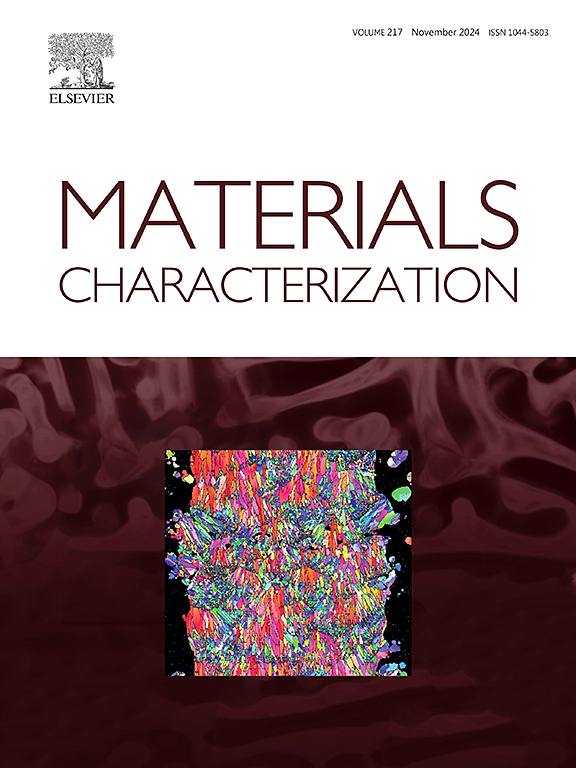界面碳化物促进了SiC纳米晶须增强AZ91镁合金的分散和晶粒细化
IF 4.8
2区 材料科学
Q1 MATERIALS SCIENCE, CHARACTERIZATION & TESTING
引用次数: 0
摘要
由于β-SiC纳米晶须具有较高的强度和与MgAl合金的相容性,是镁基纳米复合材料(mgmnc)的增强材料。在本研究中,SiCwh通过熔体搅拌成功地掺入AZ91合金中。采用基于同步加速器的相衬断层扫描(PCT)来表征它们的三维色散。值得注意的是,在sicwh -基体界面处观察到T2-Al₂MgC₂三元碳化物的形成,表明在加工过程中发生了界面反应。原子分辨率透射电子显微镜(TEM)显示,这些碳化物中存在纳米级偏析,表明其生长机制复杂。透射电镜(TEM)、扫描电镜(SEM)和电子背散射衍射(EBSD)进一步鉴定了SiCwh、T2-Al₂MgC₂和α-Mg之间的晶体取向关系(ORs)。这些ORs表明T2-Al₂MgC₂促进了基体中的非均相形核和晶粒细化。此外,发现界面反应增强了SiCwh的润湿和分散,改善了它们在整个基质中的分布。这些发现为界面相形成及其对微观结构演化的影响提供了新的机理认识。控制界面反应可以用来优化MgMNCs的分散和细化晶粒结构。鉴于熔体搅拌的简单性和可扩展性,该方法为工业生产具有增强性能的sic增强Mg复合材料提供了一条有前途的途径。本文章由计算机程序翻译,如有差异,请以英文原文为准。

Interfacial carbides enhance dispersion and grain refinement in melt-processed SiC nanowhisker reinforced magnesium AZ91 alloy
β-SiC nanowhiskers (SiCwh) are promising reinforcements for magnesium matrix nanocomposites (MgMNCs) due to their high strength and compatibility with Mg![]() Al alloys. In this study, SiCwh were successfully incorporated into AZ91 alloy via melt stirring. Synchrotron-based phase contrast tomography (PCT) was employed to characterise their three-dimensional dispersion. Notably, the formation of T2-Al₂MgC₂ ternary carbides was observed at the SiCwh–matrix interface, indicating interfacial reactions during processing. Atomic-resolution transmission electron microscopy (TEM) revealed nanoscale segregation within these carbides, suggesting a complex growth mechanism. The integration of TEM, scanning electron microscopy (SEM), and electron backscatter diffraction (EBSD) further identified crystallographic orientation relationships (ORs) between SiCwh, T2-Al₂MgC₂, and α-Mg. These ORs suggested that T2-Al₂MgC₂ promotes heterogeneous nucleation and grain refinement in the matrix. Moreover, interfacial reactions were found to enhance wetting and dispersion of SiCwh, improving their distribution throughout the matrix. These findings provide new mechanistic insights into interfacial phase formation and its influence on microstructure evolution. Controlled interfacial reactions can be leveraged to optimize dispersion and refine grain structure in MgMNCs. Given the simplicity and scalability of melt stirring, this approach offers a promising route for industrial production of SiC-reinforced Mg composites with enhanced properties.
Al alloys. In this study, SiCwh were successfully incorporated into AZ91 alloy via melt stirring. Synchrotron-based phase contrast tomography (PCT) was employed to characterise their three-dimensional dispersion. Notably, the formation of T2-Al₂MgC₂ ternary carbides was observed at the SiCwh–matrix interface, indicating interfacial reactions during processing. Atomic-resolution transmission electron microscopy (TEM) revealed nanoscale segregation within these carbides, suggesting a complex growth mechanism. The integration of TEM, scanning electron microscopy (SEM), and electron backscatter diffraction (EBSD) further identified crystallographic orientation relationships (ORs) between SiCwh, T2-Al₂MgC₂, and α-Mg. These ORs suggested that T2-Al₂MgC₂ promotes heterogeneous nucleation and grain refinement in the matrix. Moreover, interfacial reactions were found to enhance wetting and dispersion of SiCwh, improving their distribution throughout the matrix. These findings provide new mechanistic insights into interfacial phase formation and its influence on microstructure evolution. Controlled interfacial reactions can be leveraged to optimize dispersion and refine grain structure in MgMNCs. Given the simplicity and scalability of melt stirring, this approach offers a promising route for industrial production of SiC-reinforced Mg composites with enhanced properties.
求助全文
通过发布文献求助,成功后即可免费获取论文全文。
去求助
来源期刊

Materials Characterization
工程技术-材料科学:表征与测试
CiteScore
7.60
自引率
8.50%
发文量
746
审稿时长
36 days
期刊介绍:
Materials Characterization features original articles and state-of-the-art reviews on theoretical and practical aspects of the structure and behaviour of materials.
The Journal focuses on all characterization techniques, including all forms of microscopy (light, electron, acoustic, etc.,) and analysis (especially microanalysis and surface analytical techniques). Developments in both this wide range of techniques and their application to the quantification of the microstructure of materials are essential facets of the Journal.
The Journal provides the Materials Scientist/Engineer with up-to-date information on many types of materials with an underlying theme of explaining the behavior of materials using novel approaches. Materials covered by the journal include:
Metals & Alloys
Ceramics
Nanomaterials
Biomedical materials
Optical materials
Composites
Natural Materials.
 求助内容:
求助内容: 应助结果提醒方式:
应助结果提醒方式:


